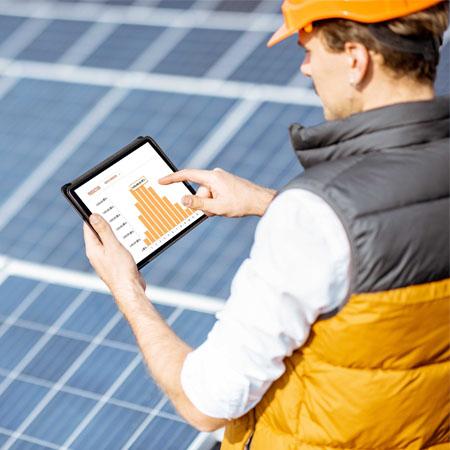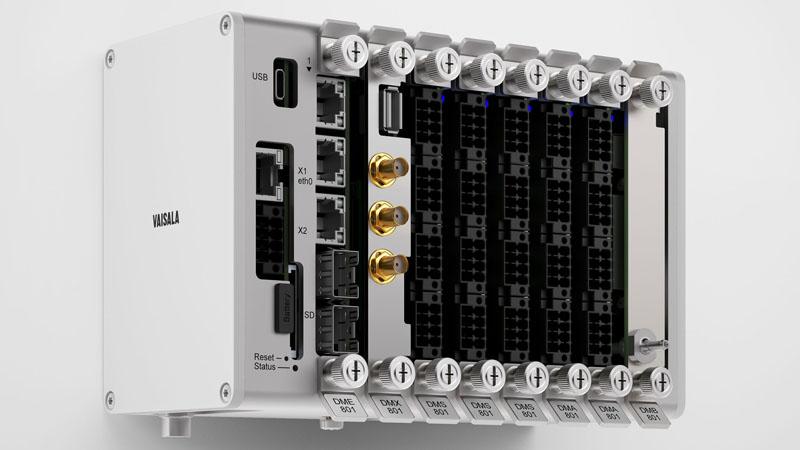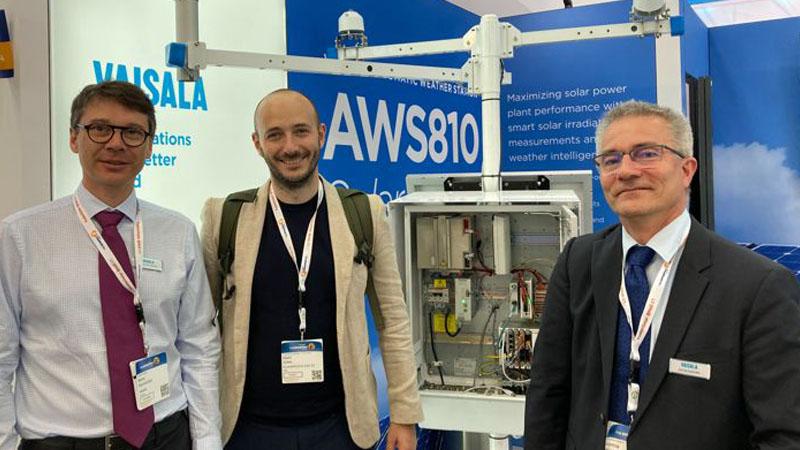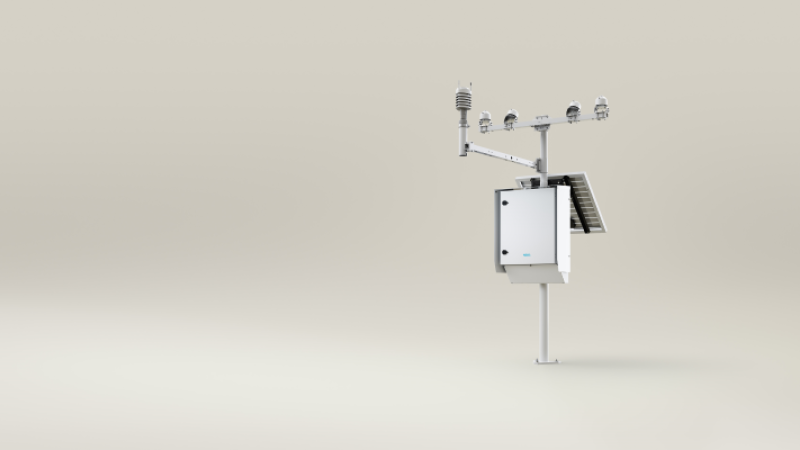Expert insights: Optimized performance monitoring for solar power plants
From left: Rémy Parmentier, Senior Market Manager, Vaisala Renewable Energy. Marc Giles, Commercial Manager, Eurelettronica. Jorma Islander, Product Manager, Vaisala.
Marc Giles, Sales Manager at Eurelettronica Icas S.r.l., speaks on the growth of the renewable energy market in Italy and Europe, particularly solar energy, and the importance of accurate weather parameters to optimize performance in solar power plants.
Tell us about your experience in the Renewable Energy industry and your current role in Eurelettronica.
Eurelettronica Icas is a long-time Vaisala Representative and Certified Service Partner in Italy. Currently I’m working as Sales Manager and I have extensive experience in the energy sector, coming from the O&G industry in my previous occupation. At Eurelettronica, I am dedicated to developing the renewable energy market in Italy and have built up a good amount of experience during the past six years.
What are your insights on the future market growth of renewable energy sources, particularly solar energy, within Italy and the European region?
Italy is one of the countries in Europe with the greatest potential for solar energy: We definitely have plenty of sun! Solar energy had an initial rush more than ten years ago when the market was heavily subsidized, but has faced some challenging years since the subsidies ended. However, the market started to grow once development prices came down and PV plants became highly competitive with other power sources. It’s still not growing at the pace it could because the approval process is slow and the whole market is subject to politics; the number of projects is enormous, but they usually take three to five years to get approved.
What weather parameters are the most critical to measure in a solar power plant, and why?
Sun irradiance, of course! Both Global Horizontal and Plane of Array (PoA) tilted irradiance, as these are critical to evaluate plant performances (PoA) and compare plants in different locations (Global).
For PV installations with bi-facial panels, ground reflected irradiance on the PoA is crucial to monitor site performance. Albedo might give a good site-to-site comparison parameter, since the terrain composition is uniform throughout the site.
Other critical parameters are:
- ambient and module temperature: they affect panel performance
- wind: it can contribute to cooling down the panels
- rain: it often helps in cleaning the panels
- soiling: to improve the cleaning activities scheduling, which can lower costs
How important are on-site accurate, reliable, real-time weather and solar measurements for optimizing solar power plant performance?

I would say that the bigger the plant, the more important it is to have extremely accurate parameters. Instruments (and satellites) are by no means perfect instruments and each has its own grade of uncertainty. However, losing 3 or 4 percentage of power production on a small rooftop plant might still be acceptable, while losing the same amount on a big utility scale site could result in huge economical losses. At the end of the day, it really comes down to what is the optimal solution in terms of cost and performance. But it is really important to consider a couple of factors when deciding which kind of instrument or solution to adopt in operations:
How much are you ready to lose in actual production to save, say, a thousand Euros during the EPC phase?
In laboratory conditions, most instruments can achieve similar performance, but in field conditions, this changes a lot. This is why at Eurelettronica we always recommend high quality Class A pyranometers and at least professional grade weather sensors, as they are the only type of instrument that can guarantee a good level of uncertainty throughout the day and in all conditions (especially in rapidly changing cloud coverage).
How does the advanced data logger in Vaisala’s latest DMU801 help with optimization?
A data logger dedicated to monitoring instrumentation can facilitate the efficient and accurate collection of weather-related data, enable effective performance monitoring, and contribute to the optimal performance of solar monitoring system. The data logger can be critical in several ways:
- Weather data loggers do preliminary quality checks on data from the instruments and can eventually flag or discard unreliable data
- It can interrogate the sensors with a high frequency without increasing the data flow to the whole SCADA system; the logger can then average the data over a set timeframe and send it at a required and acceptable frequency to the SCADA system, reducing the flow
- The logger can handle alarms and monitor instrument messages and errors, granting a whole additional level of control over the monitoring system
- It can implement calculations to deliver final data to the SCADA system (such as Albedo)
What do you think are the biggest improvements with DMU801?
The latest DMU801 comes with a series of features that represent consistent improvements when compared to most data loggers:

- Its modular design lets you tailor the logger to the specific application, to handle a single instrument or several with the same ease of use
- The integrated protections on the power and data lines simplifies cabinet design, significantly reducing potential points of failure and resulting in faster and cleaner installation
- The open architecture allows for additional tailored programming (if you know Python!)
- Using a logger that has been designed to work under the harshest conditions virtually eliminates loss of data
- The possibility of future developments and additional services when using a Vaisala logger or weather station is a great addition and is unique in the current PV market
According to your experience, what are the most critical challenges of installing a weather monitoring station at a PV plant?
It all comes down to how well you prepare and the type and accuracy of information you received from the EPC (Engineering, Procurement and Construction) company.
The most critical elements during installation would be the compatibility of mechanical interfaces for field instruments on the panel supporting structures, the site preparation activities (e.g., basements for towers), the instrument installation and levelling, as well as proper cable connections.
DMU801 helps with the latter, and skilled personnel (as Eurelettronica Service team is) will guarantee a successful installation overcoming some of the site challenges that we often see, not only on a PV plant. With installation experience in motorways, airports and remote locations, we have the competency and expertise to easily overcome challenges in a PV plant.
What would you say are the biggest challenges currently in performance monitoring?
Education, education, education. There still are few operators or companies who understand the value of:- proper monitoring
- understanding the different technologies available
- different levels of uncertainty related to these technologies
- different levels of quality in different manufacturers
For example, having a regular dome on a pyranometer or temperature sensor capable of operating in every humidity condition might seem like a minor improvement, but again, errors can have a consistent economic impact on a PV plant.
Vaisala has partnered with Eurelettronica for many years and has recently expanded in solar energy. What wishes you would have for Vaisala in regards to our future cooperation in this field? Could you also tell about your first experiences with our new weather station for solar power plants, Vaisala AWS801 Solar Edition?
Eurelettronica and Vaisala have been successfully partnering since the late 1970s, and probably the long-lasting relationship is a testament of this mutual success. Having the chance to extend our collaboration on the solar (and wind) energy market will give us more opportunities to further grow together and benefit from our assets and competencies.
We are proud of having been the first partner pioneering and fostering the first orders for the AWS810 Solar Edition, and we hope this is a good start to another successful joint market development in Italy. Thank you!

